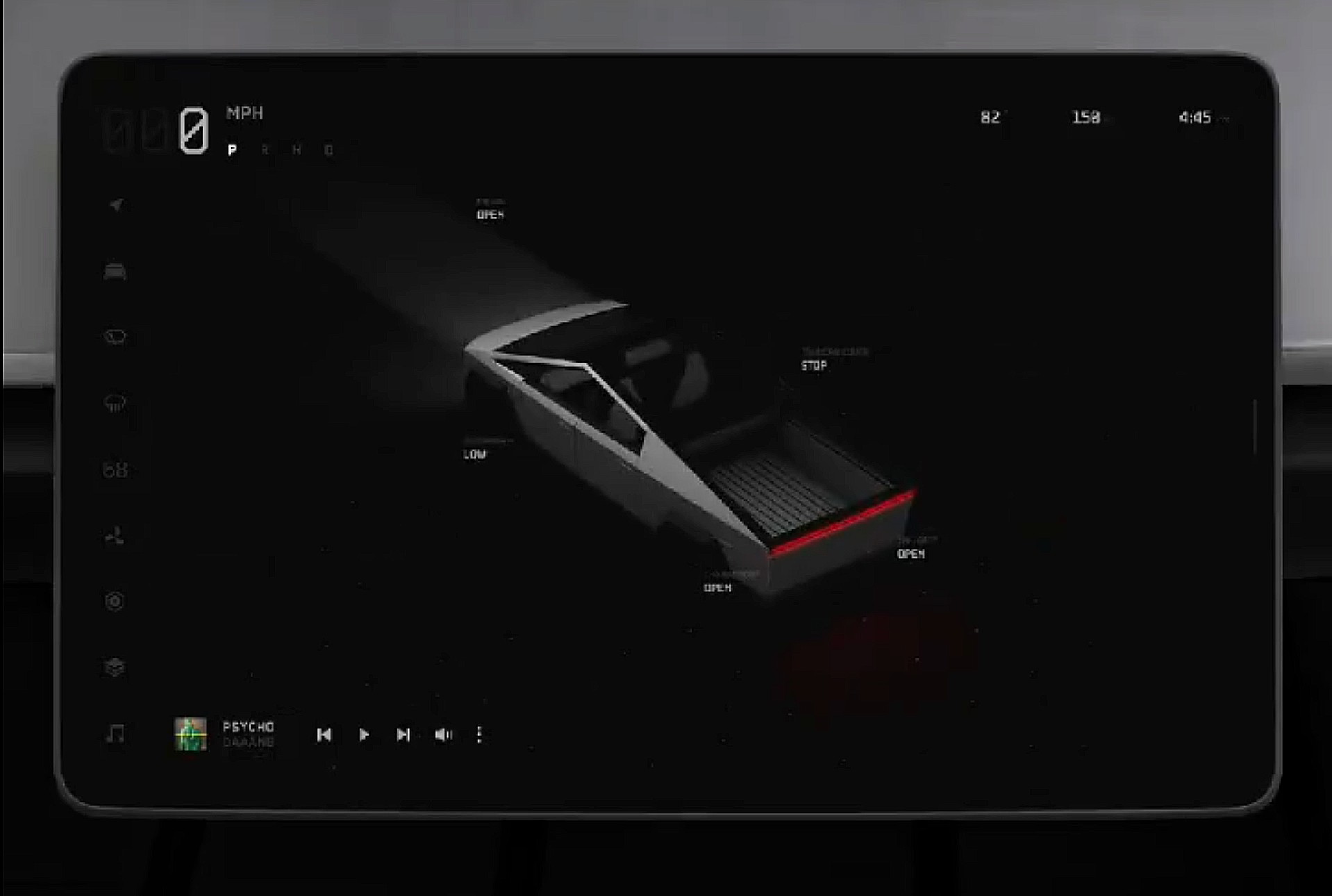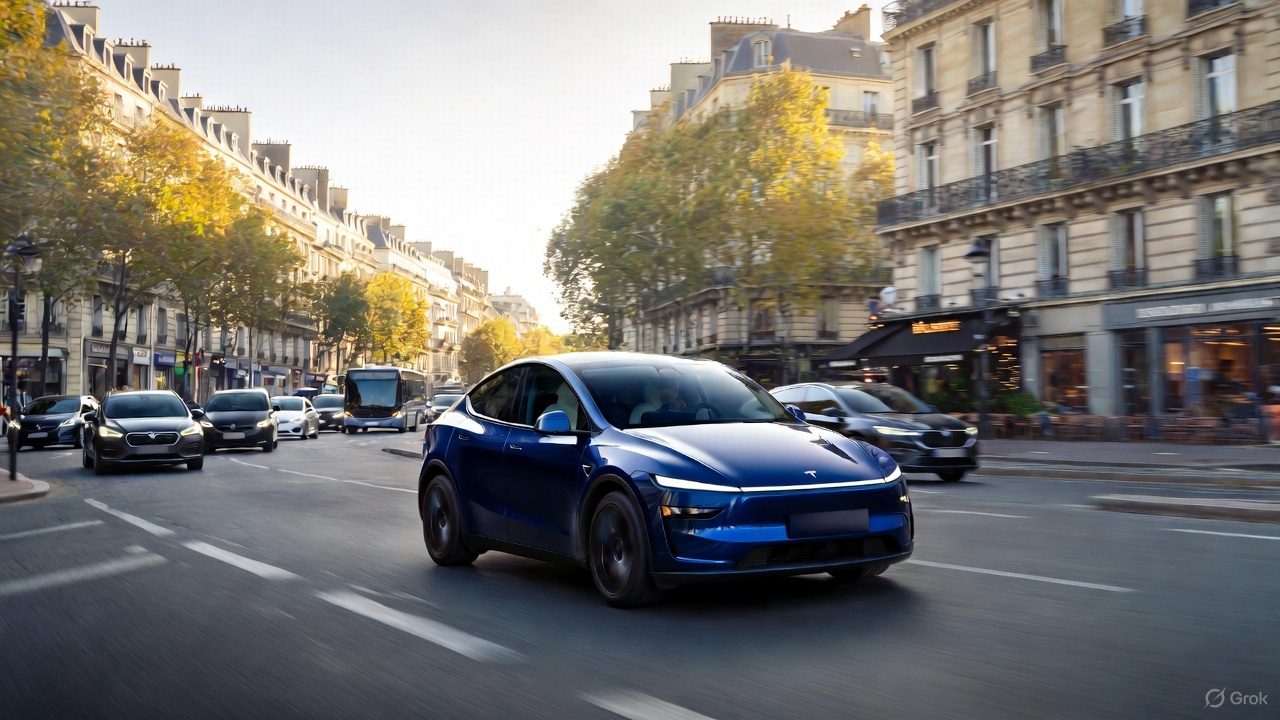

News
Former Tesla UI designer teases Cybertruck design, Full Self-Driving animations
A former Tesla UI designer’s renders of the Cybertruck design, along with never-before-seen Full Self-Driving animations, have been revealed from his personal website. Pawel Pietryka, who left Tesla in mid-March to pursue other interests, served the company for 4.5 years, frequently presenting new ideas and designs to CEO Elon Musk. After leaving the company, there were several new renders and animations that revealed the Cybertruck and Full Self-Driving animations that have remained elusive to the community.
The new renders and designs were recovered from Pietryka’s website but have now been removed following the Tesla community getting their hands on them. While it is not necessarily known if these were official Tesla renders and animations, the fact that they have disappeared from Pietryka’s website reveals that they could have been sensitive to Tesla’s designs and plans for future versions of FSD. Additionally, the Cybertruck UI animations could be utilized within the electric pickup when it hits the market later this year.
Cybertruck Render and Animation
Cybertruck UI is incredible. I can’t wait! pic.twitter.com/wZ9Zo8MYWu
— MotherFrunker #FSDBetaCanada ?? (@MFrunker) April 28, 2021
Pietryka’s Cybertruck rendering seems to show the vehicle’s interior, along with the planned animation and UI infrastructure that Tesla could use when the truck begins deliveries in late 2021. It appears to show a route and navigation summary that is similar to what real-world owners would view as they set out to drive their car to a destination. Relatively simple in design, the render and animations have not been seen before. With Pietryka being the former head of the UI design team at Tesla, there is likely some correlation between what was posted on his website and what Tesla will actually use within the Cybertruck.
The Cybertruck has been in development for several years and has undergone intense scrutiny from Tesla and its designers, along with potential owners since its unveiling in 2019. CEO Elon Musk has said that the Cybertruck underwent a slight redesign to make the truck slightly more compact. Most people were worried about getting the truck into their garage. Still, Musk was more concerned about the potential issues that the company could have with fitting it into the Boring Company tunnels comfortably. Musk told Joe Rogan earlier this year that Tesla adjusted the size by “around 3% or smaller. You don’t want it to be a couple of inches too big for the tunnel.”
Full Self-Driving Animations
A possible look at what V11 could bring. The designer who led the Tesla UI design left last month to start his own design company
Source: https://t.co/R9YGk7QmtH before it was taken down pic.twitter.com/85Mrh6oAUm
— Tesla Owners Online (@Model3Owners) April 28, 2021
The FSD Animation gave some owners and enthusiasts, like @Model3Owners, the idea that it could be a look at what Software Version 11 could bring. Tesla released some of the V11 features through the Holiday Update in late 2020, but there were several things that went unchanged. This could simply be due to FSD still being worked on, which Tesla outlined during the recent Earnings Call.
Musk said that Full Self-Driving Beta is continuing to “make great progress,” and Tesla is developing more extensive training software that will help with labeling. However, Tesla could be looking to redesign the Driving Visualization feature and could be leaning toward the design that Pietryka posted on his website. Like the Cybertruck render, this has also been removed.
As for Pietryka, he founded Moderne Grafik Anstalt Inc. in 2019, and it appears that his plans are to focus on this instead of Tesla’s work. He joined Tesla in 2016 after leaving Apple, where he crafted “new product narratives” and was responsible for hardware launches.
After 4.5 years at Tesla, today is my last day. I’ll miss these sweet fools so much, such incredible designers and humans. xo https://t.co/qNKcJCnZ7i
#tesla #productdesign #ui #uiux #ux #cybertruck #models #model3 #modely pic.twitter.com/PEgJAhH9CG— Pawel Pietryka (@pawelpietryka) March 11, 2021

News
Man credits Grok AI with saving his life after ER missed near-ruptured appendix
The AI flagged some of the man’s symptoms and urged him to return to the ER immediately and demand a CT scan.

A 49-year-old man has stated that xAI’s Grok ended up saving his life when the large language model identified a near-ruptured appendix that his first ER visit dismissed as acid reflux.
After being sent home from the ER, the man asked Grok to analyze his symptoms. The AI flagged some of the man’s symptoms and urged him to return immediately and demand a CT scan. The scan confirmed that something far worse than acid reflux was indeed going on.
Grok spotted what a doctor missed
In a post on Reddit, u/Tykjen noted that for 24 hours straight, he had a constant “razor-blade-level” abdominal pain that forced him into a fetal position. He had no fever or visible signs. He went to the ER, where a doctor pressed his soft belly, prescribed acid blockers, and sent him home.
The acid blockers didn’t work, and the man’s pain remained intense. He then decided to open a year-long chat he had with Grok and listed every detail that he was experiencing. The AI responded quickly. “Grok immediately flagged perforated ulcer or atypical appendicitis, told me the exact red-flag pattern I was describing, and basically said “go back right now and ask for a CT,” the man wrote in his post.
He copied Grok’s reasoning, returned to the ER, and insisted on the scan. The CT scan ultimately showed an inflamed appendix on the verge of rupture. Six hours later, the appendix was out. The man said the pain has completely vanished, and he woke up laughing under anesthesia. He was discharged the next day.
How a late-night conversation with Grok got me to demand the CT scan that saved my life from a ruptured appendix (December 2025)
byu/Tykjen ingrok
AI doctors could very well be welcomed
In the replies to his Reddit post, u/Tykjen further explained that he specifically avoided telling doctors that Grok, an AI, suggested he get a CT scan. “I did not tell them on the second visit that Grok recommended the CT scan. I had to lie. I told them my sister who’s a nurse told me to ask for the scan,” the man wrote.
One commenter noted that the use of AI in medicine will likely be welcomed, stating that “If AI could take doctors’ jobs one day, I will be happy. Doctors just don’t care anymore. It’s all a paycheck.” The Redditor replied with, “Sadly yes. That is what it felt like after the first visit. And the following night could have been my last.”
Elon Musk has been very optimistic about the potential of robots like Tesla Optimus in the medical field. Provided that they are able to achieve human-level articulation in their hands, and Tesla is able to bring down their cost through mass manufacturing, the era of AI-powered medical care could very well be closer than expected.
News
Tesla expands Model 3 lineup in Europe with most affordable variant yet
The Model 3 Standard still delivers more than 300 miles of range, potentially making it an attractive option for budget-conscious buyers.

Tesla has introduced a lower-priced Model 3 variant in Europe, expanding the lineup just two months after the vehicle’s U.S. debut. The Model 3 Standard still delivers more than 300 miles (480 km) of range, potentially making it an attractive option for budget-conscious buyers.
Tesla’s pricing strategy
The Model 3 Standard arrives as Tesla contends with declining registrations in several countries across Europe, where sales have not fully offset shifting consumer preferences. Many buyers have turned to options such as Volkswagen’s ID.3 and BYD’s Atto 3, both of which have benefited from aggressive pricing.
By removing select premium finishes and features, Tesla positioned the new Model 3 Standard as an “ultra-low cost of ownership” option of its all-electric sedan. Pricing comes in at €37,970 in Germany, NOK 330,056 in Norway, and SEK 449,990 in Sweden, depending on market. This places the Model 3 Standard well below the “premium” Model 3 trim, which starts at €45,970 in Germany.
Deliveries for the Standard model are expected to begin in the first quarter of 2026, giving Tesla an entry-level foothold in a segment that’s increasingly defined by sub-€40,000 offerings.
Tesla’s affordable vehicle push
The low-cost Model 3 follows October’s launch of a similarly positioned Model Y variant, signaling a broader shift in Tesla’s product strategy. While CEO Elon Musk has moved the company toward AI-driven initiatives such as robotaxis and humanoid robots, lower-priced vehicles remain necessary to support the company’s revenue in the near term.
Reports have indicated that Tesla previously abandoned plans for an all-new $25,000 EV, with the company opting to create cheaper versions of existing platforms instead. Analysts have flagged possible cannibalization of higher-margin models, but the move aims to counter an influx of aggressively priced entrants from China and Europe, many of which sell below $30,000. With the new Model 3 Standard, Tesla is reinforcing its volume strategy in Europe’s increasingly competitive EV landscape.
News
Tesla FSD (Supervised) stuns Germany’s biggest car magazine
FSD Supervised recognized construction zones, braked early for pedestrians, and yielded politely on narrow streets.

Tesla’s upcoming FSD Supervised system, set for a European debut pending regulatory approval, is showing notably refined behavior in real-world testing, including construction zones, pedestrian detection, and lane changes, as per a recent demonstration ride in Berlin.
While the system still required driver oversight, its smooth braking, steering, and decision-making illustrated how far Tesla’s driver-assistance technology has advanced ahead of a potential 2026 rollout.
FSD’s maturity in dense city driving
During the Berlin test ride with Auto Bild, Germany’s largest automotive publication, a Tesla Model 3 running FSD handled complex traffic with minimal intervention, autonomously managing braking, acceleration, steering, and overtaking up to 140 km/h. It recognized construction zones, braked early for pedestrians, and yielded politely on narrow streets.
Only one manual override was required when the system misread a converted one-way route, an example, Tesla stated, of the continuous learning baked into its vision-based architecture.
Robin Hornig of Auto Bild summed up his experience with FSD Supervised with a glowing review of the system. As per the reporter, FSD Supervised already exceeds humans with its all-around vision. “Tesla FSD Supervised sees more than I do. It doesn’t get distracted and never gets tired. I like to think I’m a good driver, but I can’t match this system’s all-around vision. It’s at its best when both work together: my experience and the Tesla’s constant attention,” the journalist wrote.
Tesla FSD in Europe
FSD Supervised is still a driver-assistance system rather than autonomous driving. Still, Auto Bild noted that Tesla’s 360-degree camera suite, constant monitoring, and high computing power mark a sizable leap from earlier iterations. Already active in the U.S., China, and several other regions, the system is currently navigating Europe’s approval pipeline. Tesla has applied for an exemption in the Netherlands, aiming to launch the feature through a free software update as early as February 2026.
What Tesla demonstrated in Berlin mirrors capabilities already common in China and the U.S., where rival automakers have rolled out hands-free or city-navigation systems. Europe, however, remains behind due to a stricter certification environment, though Tesla is currently hard at work pushing for FSD Supervised’s approval in several countries in the region.








